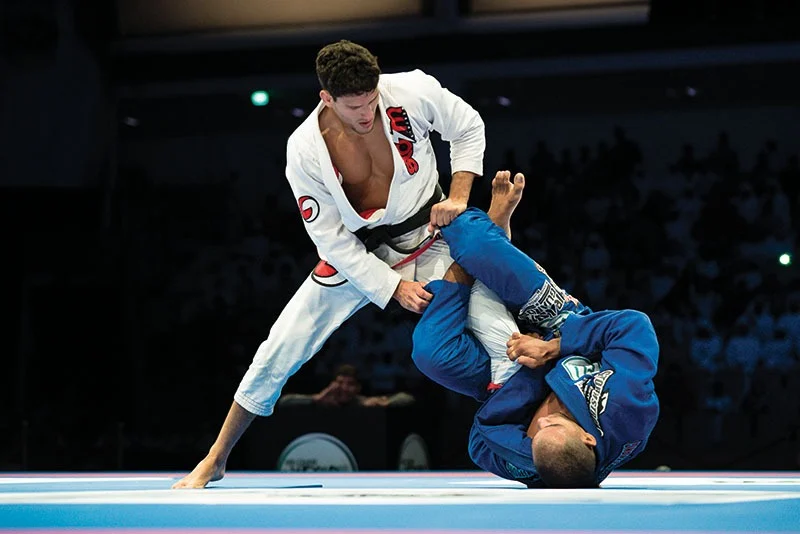Navigate This Post

Weight categories don’t just make BJJ competitions safer, but they increase their overall competitiveness as well. The numbers on the scale can make quite a difference in the performance of BJJ competitors, which is why organizations take them so seriously.
If you are planning on taking the sport of jiu-jitsu seriously, competing in IBJJF tournaments is a must. IBJJF was created in 2004 and is one of the largest governing bodies in the sport of Brazilian Jiu-jitsu. The majority of the greatest athletes that have walked through the martial art have competed on these stages and taken the title of World Champion. In this post, we will not only cover the weight classes that you would expect to be in if you were competing but also expand on some of the largest tournaments held by IBJJF on a global scale, most notably the North American and European IBJJF tournaments.
The following gives you a comprehensive overview of the weight classes in BJJ’s biggest bodies:
IBJJF Weight Classes (Adult & Masters Male)
Out of all the IBJJF weight classes for adult males, the lightest weight class is the Rooster which has a limit of 57.5 kilograms or 126.5 pounds. The weight divisions are the following:
-
- Rooster – (anyone under 57.5 kg or 127 lbs)
- Light Feather – (between 127.5lbs and 64 kg or 141.6 lbs)
- Feather – (between 142lbs and 70 kg or 154 lbs)
- Light – (between 155 lbs and 76 kg or 167 lbs)
- Middle – (between 168.1 lbs and 82.3 kg or 181 lbs)
- Medium Heavy – (between 181.7 lbs and 88.3 kg or 195 lbs)
- Heavy – (between 195.1 lbs and 94.3 kg or 208 lbs)
- Super Heavy – (between 208.1 lbs and 97.5 kg or 222 lbs)
- Ultra Heavy – (anything over 222 lbs)

There’s also the Open Class in which competitors of all weights can compete against one another without any weight restrictions.

Female or Juvenile Gi IBJJF Weight Classes
There’s a separate list of Gi weight classes for female and juvenile (under 18) athletes. As you can tell, they use similar naming conventions as the male classes, but the weight limits are different. Again, the athletes are supposed to wear their Gis during weigh-ins.
Female Adults Gi Weight Classes (IBJJF Weight Classes Gi)
The lightest weight division for female Gi competitors is the Rooster with an upwards weight limit of 47.5 kilograms or 107 pounds. You also have an open weight class where anything goes.
-
- Rooster – (anything up to 107 lbs or 47.5 kg)
- Light Feather – (between 107.1 lbs and 118 lbs or 53.5 kg)
- Feather – (between 118.1 lbs and 129.0 lbs or 58.5 kg)
- Light – (between 129.1 and 141.6 lbs or 64.2 kg)
- Middle – (between 141.7 lbs and 152.6 lbs or 69.2 kg)
- Medium Heavy – (between 152.7 lbs and 163.6 lbs or 74.2 kg)
- Heavy – (between 163.7 lbs and 175 lbs or 79.3)
- Super Heavy – (anything over 175 lbs with no maximum limit)
Technique is the most important aspect of BJJ/grappling performance. But want to increase your chances of landing submissions, finishing takedowns, and maintaining position? This program will have you man handling your opponents making them ready to tap.

Juvenile
There are juvenile categories for boys and girls at the IBJJF as well. These are the athletes who are under 18 years of age.
Juvenile Male IBJJF Weight classes Gi
Someone who competes in the juvenile weight classes is considered to be under the age of 16 and has a belt going with the kid’s system in place. The Juvenile Gi weight classes for boys are the following:
- Rooster – (anything below the weight of 118 lbs or 53.5 kg)
- Light Feather – (between 118.1 lbs and 129 lbs or 58.5 kg)
- Feather – (between 129.1 lbs and 141.6 lbs or 64 kg)
- Light – (between 141.7 lbs and 152.6 lbs or 69.2 kg)
- Middle – (between 152.7 lbs and 163.6 lbs or 74 kg)
- Medium Heavy – (between 163.7 lbs and 175 lbs or 79.3 kg)
- Heavy – (between 175.1 lbs and 186 lbs or 84.3 kg)
- Super Heavy – (between 186.1 lbs and 197 lbs or 89.3 kg)
- Ultra Heavy – ( anything above 197lbs with no maximum limit)
Juvenile Male IBJJF Weight classes N0-Gi
Someone who competes in the juvenile weight classes is considered to be under the age of 16 and has a belt going with the kid’s system in place. The juvenile male division has two separate categories probably based on age so please refer to the table below for an accurate representation of where you will be placed in this upcoming tournament! The Juvenile Gi weight classes for boys are the following (see the most left column):
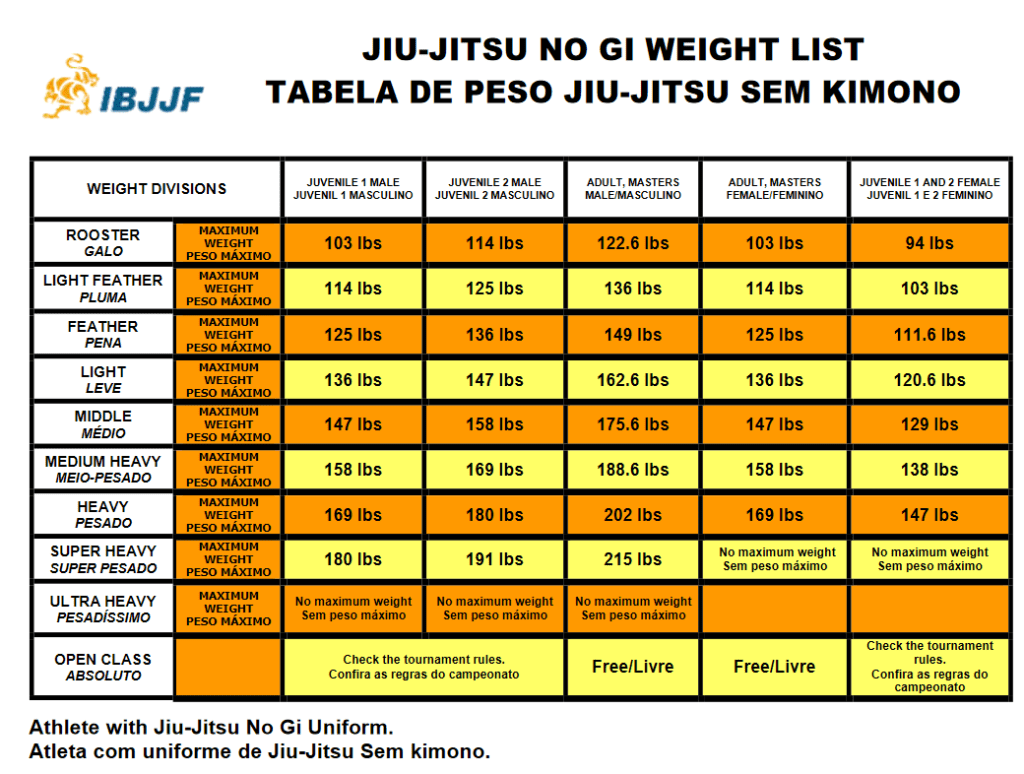
Juvenile Female IBJJF Weight Classes
The juvenile females’ Gi weight classes are shown below; there’s an open weight class as well:
-
- Rooster – (anyone below 98 lbs)
- Light Feather – (between 98.1 lbs and 106.6 lbs)
- Feather – (between 106.7 and 116 lbs)
- Light – (between 116.1lbs and 125 lbs)
- Middle – (between 125.1 lbs and 133.6 lbs)
- Medium Heavy – (between 133.7 lbs and 143.6 lbs)
- Heavy – (between 143.7 lbs and 152 lbs)
- Super Heavy – (anyone above 152.1 lbs with no maximum limit)
Juvenile Female IBJJF Weight classes N0-Gi
Someone who competes in the juvenile weight classes is considered to be under the age of 16 and has a belt going with the kid’s system in place. Just like the juvenile boys division, the juvenile female’s division is broken down in two categories most likely in relation to age but the weight classes stay the same. The juvenile females’ Gi weight classes are shown below; there’s an open weight class as well:
-
- Rooster – (anyone below 94 lbs)
-
- Light Feather – (between 94.1 lbs and 103 lbs)
-
- Feather – (between 103.1 and 111.6 lbs)
-
- Light – (between 111.7 lbs and 120.6 lbs)
-
- Middle – (between 120.7 lbs and 129 lbs)
-
- Medium Heavy – (between 129.1 lbs and 138 lbs)
-
- Heavy – (between 138.1 lbs and 147 lbs)
- Super Heavy – (anyone above 147.1 lbs with no maximum limit)
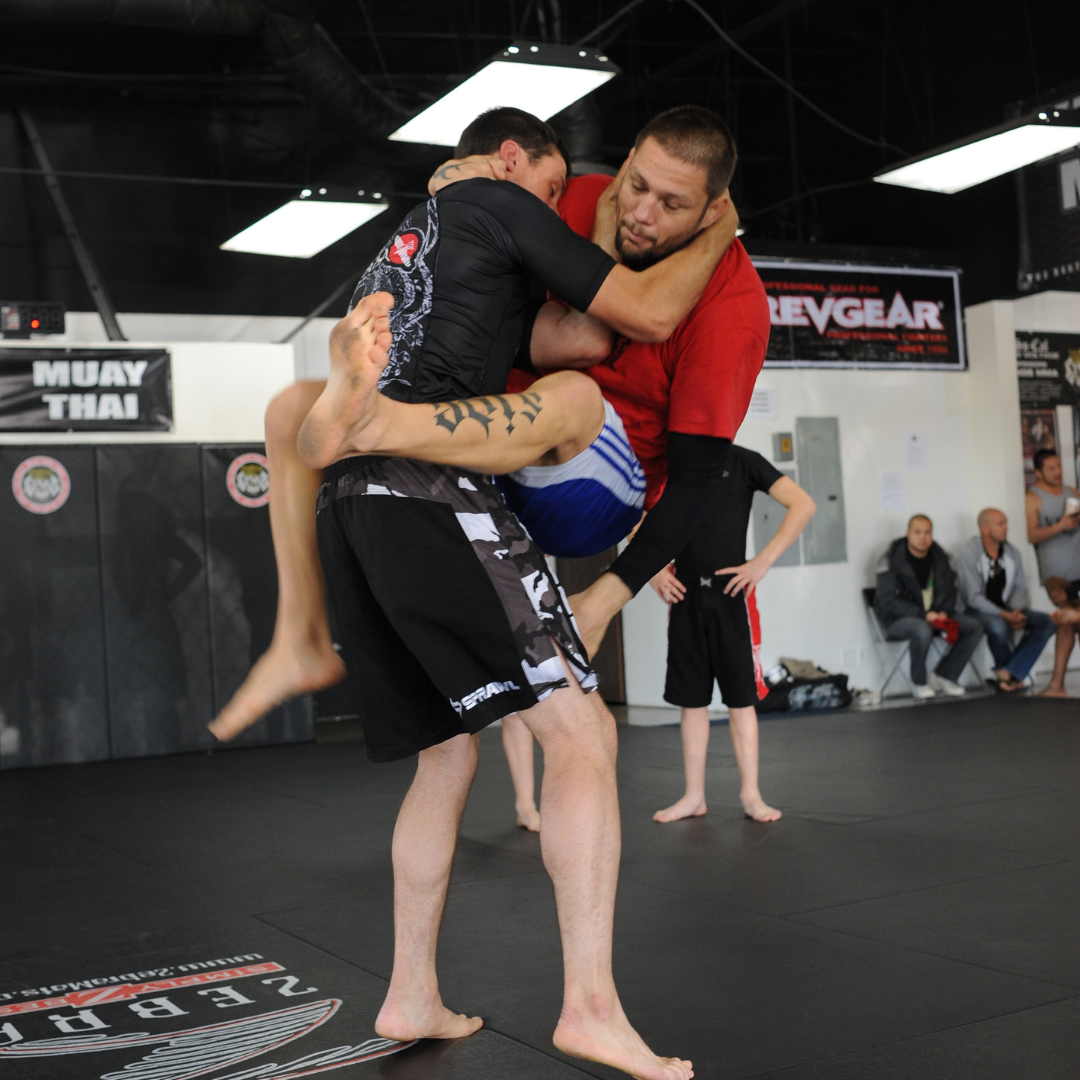
IBJJF Male Adults and Masters Weight Classes (No Gi)
We start the No Gi weight classes with the adult males and masters categories. The lightest of the weight divisions allows athletes to weigh up to 51.5 kilograms or 114 lbs. The classes are the following:
- Rooster – (anything below the weight of 122.6 lbs)
- Light Feather – (between 122.7 lbs and 136 lbs)
- Feather – (between 136.1 lbs and 149 lbs)
- Light – (between 149.1 lbs and 162.6 lbs)
- Middle – (between 162.7 lbs and 175.6 lbs)
- Medium Heavy – (between 175.7 lbs and 188.6 lbs)
- Heavy – (between 188.7lbs and 202 lbs)
- Super-Heavy – (between 202.1 lbs and 215 lbs)
- Ultra Heavy – (anyone over 215.1 lbs with no maximum limit)
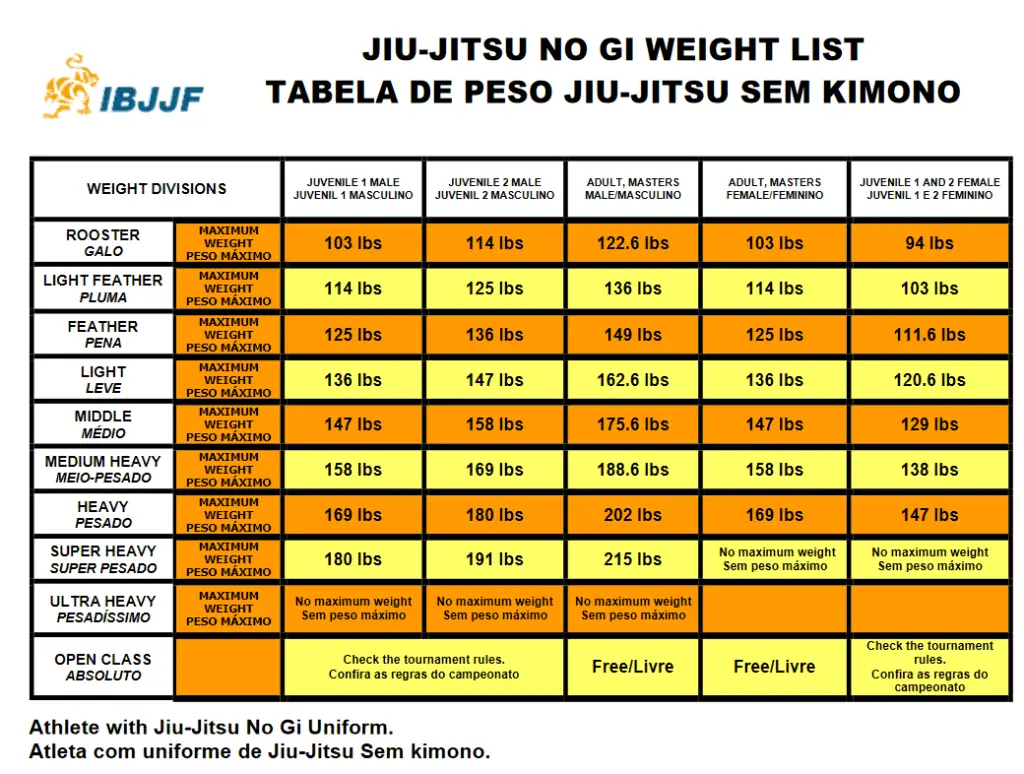
IBJJF Female Adults and Masters Weight Classes (No GI)
The adult female No Gi weight classes are as shown below. The lightest weight division allows up to 42.5 kilograms or 94 pounds.
-
-
-
- Rooster – (anything below the weight of 103 lbs)
-
- Light Feather – (between 103.1 lbs and 114 lbs)
-
- Feather – (between 114.1 lbs and 125 lbs)
-
- Light – (between 125.1 lbs and 136 lbs)
-
- Middle – (between 136.1 lbs and 147 lbs)
-
- Medium Heavy – (between 147.1 lbs and 158 lbs)
-
- Heavy – (between 158.1 lbs and 169 lbs)
- Super-Heavy – (anyone over 169.1 lbs with no maximum limit)
-
-
What Are the Different IBJJF Weight Classes?
The various IBJJF weight classes are the Rooster, Light Feather, Feather, Light, Middle, Medium Heavy, Heavy, Super Heavy, and Ultra Heavy. The contests for adult female Gi and No Gi athletes don’t have Ultra Heavy. The juvenile female contests also ditch the Rooster class.
- Difference Between Weight Classes of IBJJF and ADCC
The IBJJF and the ADCC are two of the biggest organizations as far as Brazilian Jiu Jitsu competitions are concerned. There are several differences in their weight categories though. The most notable one is that the ADCC’s weight classes have bigger gaps between them.
There are different weight classes for the ADCC teams, the world championship, and their national and open categories. The organization also has different weight classes based on the level of experience of the competitors.
There are also fewer weight classes for female athletes competing in the championship. This makes the official IBJJF weight classes safer.
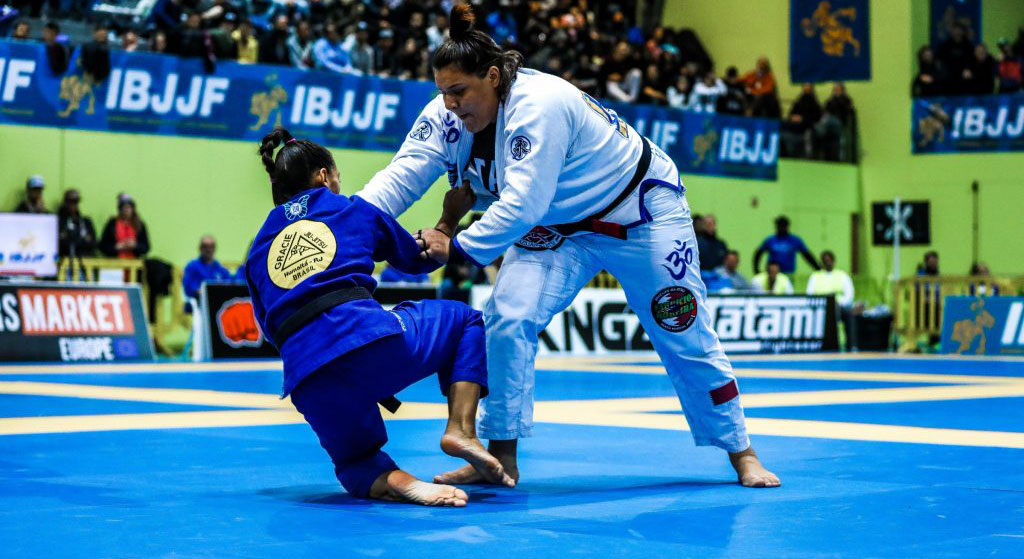
Are IBJJF weight classes the same for all the different IBJJF tournaments?
Yes, the rules regarding the IBJJF weight classes remain the same no matter which of its tournaments and special events one takes part in. The location of the contest also doesn’t make a difference in this regard.
Are Adults and Masters IBJJF Divisions the Same?
The divisions are the same for the adults and masters competing in the IBJJF. Note that there are more weight categories for male adults and masters as compared to their female counterparts.
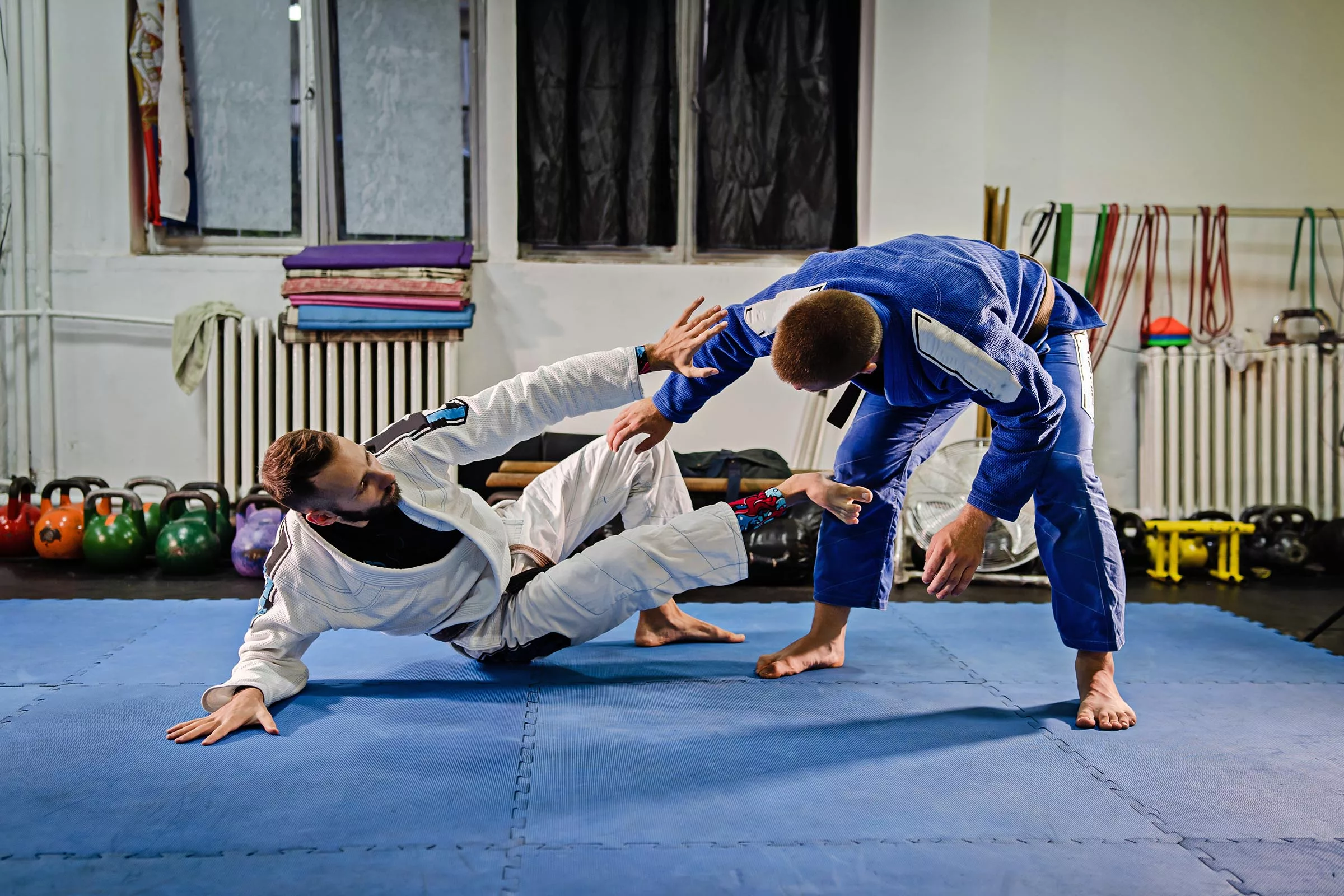
Weighing In Before A Tournament (IBJJF)
There are a couple of IBJJF rules that must be followed during a weigh-in. Whether it is a No Gi or Gi competition, the athlete must be in proper uniform while on the scale. If they fail to make the required weight, they’ll be disqualified.
There are no second chances offered and the competitor won’t be able to switch weight classes. They won’t be given a refund either.
Use code 'GRAPPLERSGRAVEYARD' for 15% off your entire order
- High Quality Material
- Comfortable and Fits Body Perfectly
- Grade-A Designs
IBJJF Championship Series
The International Brazilian Jiu-Jitsu Federation (IBJJF) is the largest governing body that Jiu-Jitsu has to offer. IBJJF hosts some of the world’s largest (GI and now nogi) tournaments that get huge turnouts regardless of the time of year or locality. The IBJJF hosts a world ranking system where athletes who compete in their tournaments are able to see a live ranking of where they sit amongst other competitors around the world.
Not only does the IBJJF set the standard for things like weight classes and rule sets, they are also one of the world’s biggest tournament hosts. Most of Jiu-Jitsu’s growth can be seen in these large-scale tournaments like IBJJF or ADCC. Each year we see a compounding effect playing out just by the sheer number of athletes traveling worldwide to showcase their talents on a World Stage. Many athletes train year-round and set up their schedule to reach their peak for these tournaments much like they do for tournaments like ADCC.
Because of the success and popularity of tournament formats like ADCC, IBJJF has pivoted to hosting more nogi tournaments. The once-traditional Brazilian Jiu-Jitsu Organization is moving with the times and adopting more buzz due to this which is only leading to more growth of the sport and company.
IBJJF Tournaments (Pans, EU World Championship, NA World Championships, and More)
IBJJF Tournaments are hosted year-round and all around the Globe. To find a calendar for the next IBJJF tournament near you their site has a running list here. The biggest tournaments that IBJJF hosts throughout the year are going to be the following:
- American National IBJJF No-Gi Championship
- American National IBJJF Gi Championship
- European IBJJF Jiu-Jitsu Championship
- Pan IBJJF Jiu-Jitsu Championship
- Pan IBJJF Jiu-Jitsu No-Gi Championship
- World Master IBJJF Jiu-JItsu Championship
- International Open IBJJF Jiu-Jitsu No-Gi Championship
- International Open IBJJF Jiu-Jitsu Championship
At some of the world’s largest tournaments listed above, IBJJF has been known to have close to 10,000 competitors sign up and compete for the chance to win gold. IBJJF is no stranger to elite levels of competition and athletes who go into these should be ready for what’s at stake.
IBJJF European Championship
IBJJF World championships are just around the corner. The most exciting Gi event on the planet is an opportunity for athletes around the world to further build their legacy and establish their dominance in the competitive circuit but it is also a chance for newcomers to come in and make some noise, make a claim for their name and etch their name in history.
History of IBJJF European World Championships
The first IBJJF EU World Championship was hosted in 2004, marking a significant moment for the development of Brazilian jiu-jitsu in Europe. In the initial years, the championship served as. a platform to bring together BJJ practitioners from various European countries. The competition aimed to provide a stage for athletes to test their skills and foster a sense of community within the EU BJJ scene.
As the years progressed, The EU championship experienced exponential growth (much like the sport of BJJ has seen over the past 10 years). The tournament has been hosted in many cities across Europe, reflecting the expansion of popularity of Brazilian Jiu-Jitsu and the increased demand to accommodate more competitors. Today, the European BJJ scene is known for its high-level competitors and attracts some of the best talent in the world to compete on the world stage.
Like other IBJJF tournaments, the EU championship has evolved in terms of rules and format. Adaptions have been made to ensure fairness, safety, and compliance with the evolving standards of the sport. All the latest rules should be found directly on their site for the highest level of trust (source).
The next IBJJF European Championship will be hosted January 19th – January 27th, 2024 in Paris, France.
Notable Historic Moments & Cultural Impact
Throughout its history, the European Championship has witnessed numerous memorable moments and showcased the talents of exceptional athletes like the late Leandro Lo who has been coined as one of the best pound-for-pound grapplers to have ever lived. His coveted career was full of IBJJF world championships across multiple weight classes for many years. As the influence of BJJ has continued to spread (and it has rapidly grown even over the last 5 years) many more champions will emerge and etch their name into history with some of the greats.
The EU championship has had a significant impact on the cultural and competitive landscape of BJJ in Europe. It has played a pivotal role in shaping the identity of European Brazilian Jiu-Jitsu and fostering a highly competitive scene.
Repeat Champions or New Blood?
This year’s tournament is going to host the best of the best from both male and female divisions. Here is a table of the athletes who medaled in Gold, Silver, and Bronze last year in the EU Championship series
Just What You Need. We designed the Sanabul Essential Jiu-Jitsu Gi to set a high bar for what you can expect from a BJJ gi whether this is your first Jiu Jitsu gi or an addition to your current line up. Quality construction, clean design, and incredible value make this Brazilian Jiu Jitsu gi the #1 Best Seller in the industry
Male Medalists
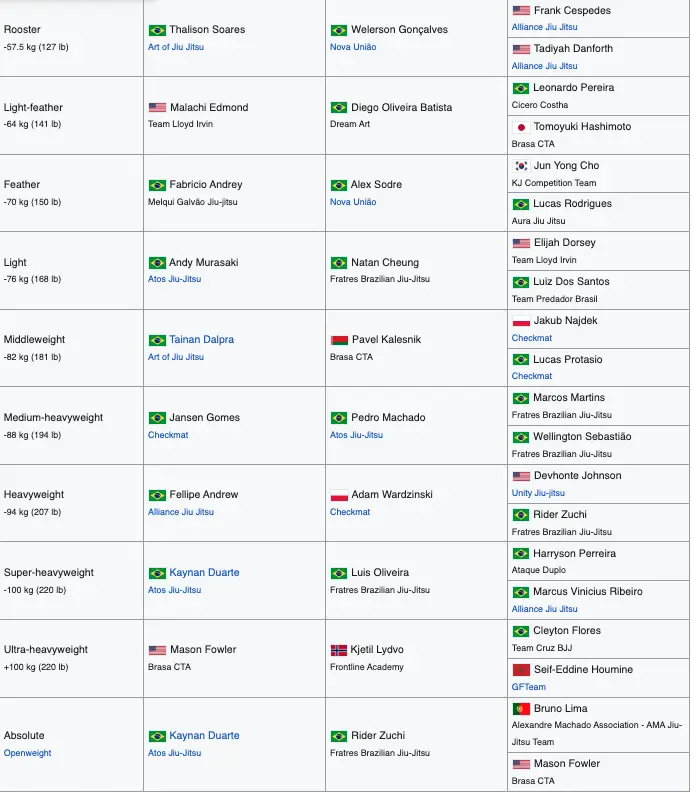
European World championships were heavily dominated by Brazilian competitors throughout the weekend. The country of Brazil has an athlete in every weight class who placed in the top four. Pure dominance was on display in 2023 and they are poised to do it all over again in 2024.
A notable name to look out for in 2024 will be Mason Fowler. In 2023, Mason made his black belt debut and took the world championship in one of the most competitive divisions ( the same on that hosts the King, Gordon Ryan). The week before Fowler took the stage at Gi Worlds, he was off fighting in a no-gi super fight that ended up putting $25,000 in his pocket. Fowler submitted all but one person on his way to gold in the super-heavyweight weight class at The European World Championships. Fowler also took 3rd in the absolute division which is no small feat of its own.
There were was not much American representation at the European World stage but that is expected since the United States has its own hosted World Championship.
Female Medalists
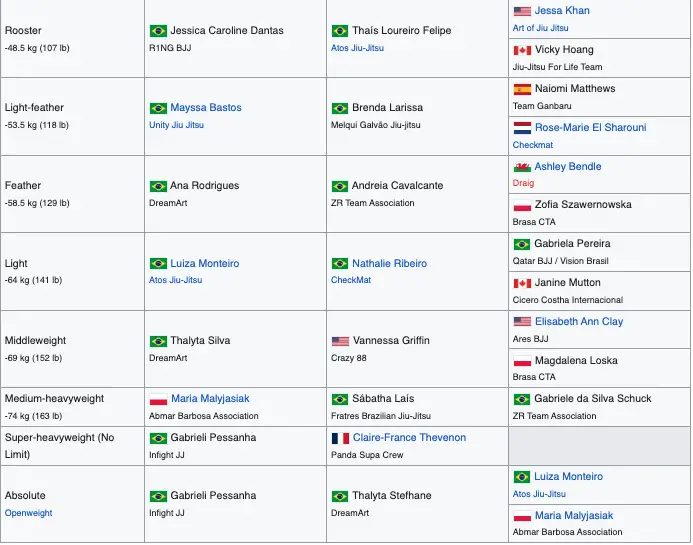
Just like the male tournament, the female European competitive scene was widely dominated by Brazilians. In 2024 we expect no different but there should be some notable names out there worth paying attention to.
Elizabeth Clay was one the of few American women who medaled the weekend of EU Worlds in 2023. We had the pleasure of meeting her and watching her compete in ADCC back in 2022 and the growth in her grappling is noticeable. Names to also look out for:
- Ffion Davies
- Gabrieli Pessanha
- Vanessa Griffin
Use code 'GRAPPLERSGRAVEYARD' for 15% off your entire order
- High Quality Material
- Comfortable and Fits Body Perfectly
- Grade-A Designs
IBJJF Tournament Ruleset & Format
The IBJJF is known for having. a bit of a stricter rulset than some of the more well-known BJJ organizations that are out there. Frankly, the rules are too much to put into this article and would result in the page being way to long. The entire guide for IBJJF rules, fouls, illegal moves, and code of conduct can be found directly on their site (source).
Uniform Requirements
Gi Material
GIs should be tailored using cotton or cotton-like fabric only. The fabric should not be so thick or hard as to impede an opponent from gripping it. For juvenile, adult, master and senior divisions, a GI fashioned from woven fabric is mandatory.
Gi Color and Patches
GIs must be of uniform color.
The following colors are permissible: white, royal blue or black. Gis with tops and pants of different colors are not permitted; nor are GIs with a collar that is a different color than the rest of the top.
Painted GIs are forbidden, unless the paint is designed in the form of an academy or sponsor logo – and only on regions of the GI where patches are permitted.
Even in cases where they are permitted, the athlete will be obliged to change GIs should the paint mark the GI of the opponent.
Belt Requirements
Athletes should use a durable, 4 to 5 cm wide belt colored according to the athlete’s rank, with a black tip – except for black belts, where the tip should be white or red. The belt should be worn over the top, wrap around the waist twice, and be tied using a double knot tight enough to hold the GI top closed. Once tied in a double knot, each end of the belt should hang 20 to 30 cm in length.
Gi Measurements
The GI top should reach the athlete’s thigh and the sleeves should come to no more than 5 cm from the athlete’s wrist when the arm is extended straight parallel to the ground.
GI pants should reach no more than 5 cm above the ankle bone.
No-Gi Requirements
Shirts and Rash Guards
Both genders must wear a shirt of elastic material (skin tight) long enough to cover the torso all the way to the waistband of the shorts, colored black, white, or black and white, and with at least 10% of the rank color(belt) to which the athlete belongs. Shirts 100% the color of the athlete’s rank (belt) are also permitted.
Shorts For Men
Board shorts must be colored black, white, black and white, or the color of the rank (belt) to which the athlete belongs to. Shorts must not have any zipper or any form of plastic that could present hard to the opponent, must cover half the thigh, and cannot be longer than the knees. You can wear spats underneath your board shorts.
Shorts, Compression Shorts and Pants For Women
Shorts, compression pants (skin-tight spats), or compression shorts colored black, white, black and white, and/or the color of the rank (belt) to which the athlete belongs. The shorts must not have pockets or have the pockets stitched completely shut, must not have buttons, zipper, or any other kind of plastic that could gain cause harm to the opponent.
Anti-Doping Clause
Directly on the IBJJF Official Website (source), it states that IBJJF is opposed to the practice of doping in their tournaments and they abide by the provisions of the World Anti-Doping Code and World Anti-Doping Agency Prohibited List.
The IBJJF Anti-Doping Policy aims To do the following:
- Promote BJJ as a drug-free sport
- Uphold and preserve the ethics of the sport
- Ensure that athletes have an opportunity to compete equally
- Safeguard the physical health and mental health of athletes
- Encourage affiliate federations to execute similar regulations with their athletes
The use, possession and/or trafficking of prohibited substances, methods, or the encouragement or counseling to use prohibited substances, or methods, and/or taking measures to mask the use of prohibited substances, or methods by any participant in competitions over which the IBJJF has jurisdiction is unacceptable and will not be tolerated.
How to get an IBJJF Membership Card
To compete in IBJJF tournaments you need a membership card to identify yourself. These cards are used to validate that athletes are who they say they are and are the rank that they are competing in.
Getting a member is a necessity for you to be able to compete in these tournaments, there are no exceptions to this rule.
Lucky for you, getting one is very easy. here are the steps to get your IBJJF Membership Card:
- Go to IBJJF’s Official Website (here) and start to fill out your application
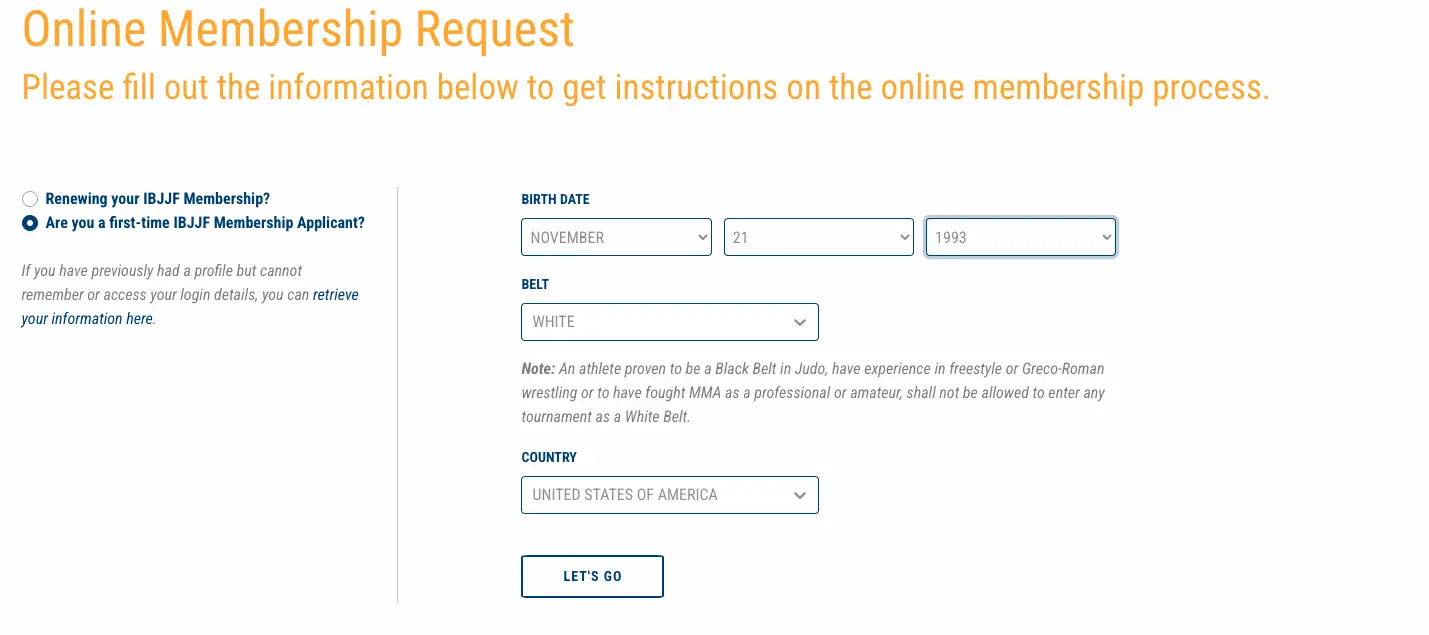
- Upload all documentation to prove your identity (Passport Style Photo, Government Issue ID) and pay the $40 processing fee
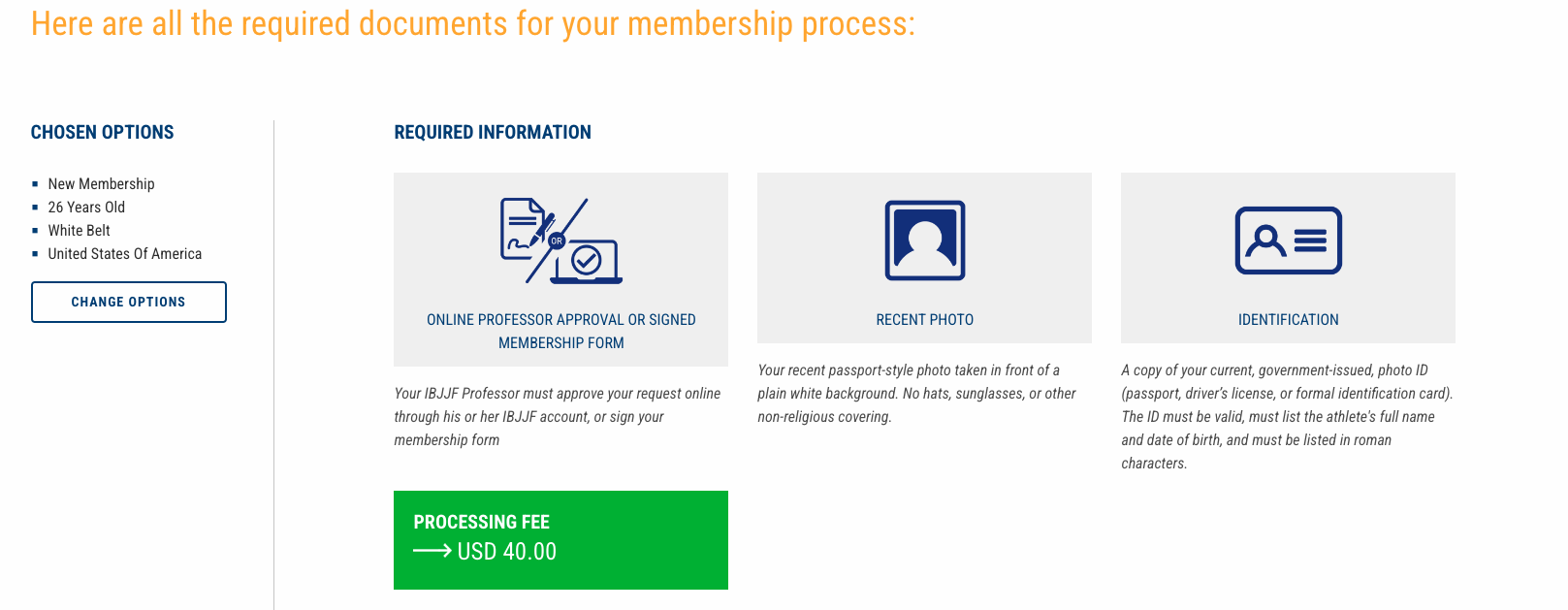
- The IBJJF team will then review the documentation that was submitted and upon approval, you are now set to compete in any IBJJF tournament around the world
*Important note* You will need to renew your IBJJF membership card each year to validate any belt changes. This is to protect athletes in the case that they get a promotion and again to validate that you are not sandbagging or competing under someone else’s name
Brief History of IBJJF
The IBJJF was founded in 1994 by Carlos Gracie Jr., a member of the renowned Gracie family who played a significant role in the development and popularization of Brazilian jiu-jitsu. Over the years, IBJJF has played a pivotal role in the global expansion of Brazilian Jiu-Jitsu. It has organized and sanctioned competitions across the globe and contributed to the now worldwide popularity of martial arts.
Over the years, the IBJJF has refined and expanded its ruleset to govern Brazilian Jiu-Jitsu competitions. This includes specific guidelines for belt promotions, competition scoring, and permissible techniques. The IBJJF rules have become a standard reference in the BJJ community. The IBJJF introduced a ranking system that awards points to competitors based on their performance in IBJJF events. These points contribute to an individual’s overall ranking within the organization and recognize their accomplishments and skill level (current rankings).
Abu Dhabi Combat Club (ADCC) Weight Classes
The weight classes in the Abu Dhabi Combat Club or ADCC Championships are Lightweight, Welterweight, Middleweight, Light Heavyweight, Heavyweight, and Absolute. As you can tell, they are fewer in number than the IBFF weight categories.
Another way in which ADCC has a different weight class system is that its categories are named similarly to the ones in boxing and MMA.
There are separate weight classes and rules for the other ADCC tournaments.
Adults and Masters Age Divisions and Match Length (ADCC)
Outside the ADCC Championship, the organization likes to divide its competitors in terms of experience, age, and gender. As far as experience is concerned, the different categories are Professional, Advanced, Intermediate, and Beginner.
These are further divided into age and gender, as you can see here.
Weight Divisions for ADCC (Men)
The following are the weight classes for the ADCC Championship for male adults, starting with Lightweight that goes up to 66 kilograms or 145.4 pounds:
-
-
Lightweight – Below 65.9 kg (below 145 lbs)
-
-
-
Welterweight – Below 76.9 kg (below 169.5 lbs)
-
-
-
Middleweight – Below 87.9 kg (below 193.7 lbs)
-
-
-
Light Heavyweight – Below 98.9 kg (below 218 lbs)
-
-
-
Heavyweight – Above 99 kg (Above 220.5)
-
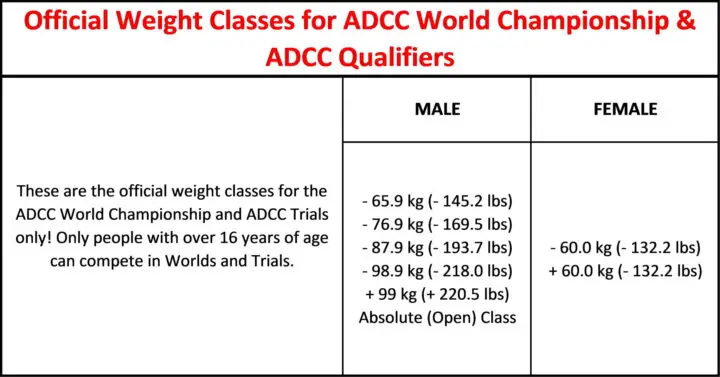
There’s also the Absolute class which is open to all weight classes.
The ADCC’s Teams competition for male adults narrows down these weight classes to just the following:
-
-
Lightweight – (83 kg or 183.0 lbs)
-
-
-
Heavyweight – (Above 83 kg or 183.0 lbs)
-
Weight Divisions for Females ADCC
For female adults competing in the ADCC Championships, and the Teams competition, the classes are the following:
-
- *NEW* Below 55 KG (Below 121.24 lbs)
-
Lightweight – (below 65 KG or 143.3 lbs)
-
-
Heavyweight – (Above 132.3 lbs)
-
Use code 'GRAPPLERS' to save 10% on your entire order
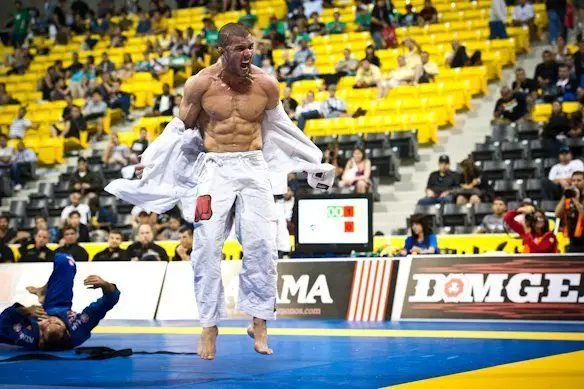
Jiu Jitsu World League (JJWL) weight classes
The Jiu-Jitsu World League or the JJWL is a body that organizes Brazilian Jiu-Jitsu competitions, produces global competitor rankings, and aims to make the sport more professional. So, it too has a weight class system, named similar to the IBJJF weight divisions. Most tournaments outside of the ADCC will fall under the same weight class set up and ruleset.
Men Adults & Masters
The JJWL weight classes for male adults are the same for Gi and No Gi competitions. They both begin with the Rooster class which allows up to 56 kilograms or 130 pounds. There’s no open weight class.
The categories are shown below:
-
-
Rooster – (56 kg or 130 lbs)
-
-
-
Light Feather – (64 kg or 141 lbs)
-
-
-
Feather – (70 kg or 154 lbs)
-
-
-
Light – (76 kg or 168 lbs)
-
-
-
Middle – (82.5 kg or 182 lbs)
-
-
-
Medium Heavy – (88.4 kg or 195 lbs)
-
-
-
Heavy – (94.3 kg or 208 lbs)
-
-
-
Super Heavy – (100.6 kg or 222 lbs)
-
-
-
Ultra Heavy – (No maximum limit)
-
Female Adults & Masters
There are slight differences in the Gi and No Gi weight categories for female adults and masters. The Gi-based weight divisions are the following:
-
-
Rooster – (45 kg or 108 lbs)
-
-
-
Light Feather – (54.4 kg or 120 lbs)
-
-
-
Feather – (59 kg or 130 lbs)
-
-
-
Light – (64.4 kg or 142 lbs)
-
-
-
Middle – (69.8 kg or 154 lbs)
-
-
-
Medium Heavy – (74.8 kg or 165 lbs)
-
-
-
Heavy – (80.2 kg or 177 lbs)
-
-
-
Heavy Plus – (No maximum limit)
-
Below are the No Gi weight categories for females:
-
-
Light Feather – (54.4 kg or 120 lbs)
-
-
-
Feather – (59 kg or 130 lbs)
-
-
-
Light – (64.4 kg or 142 lbs)
-
-
-
Middle – (69.8 kg or 154 lbs)
-
-
-
Heavy Plus – (No maximum limit)
-
Kids
Unlike the IBJJF and ADCC, the JJWL doesn’t have a fixed set of weight classes for its juvenile athletes. It states that the classes (Gi and No Gi), “are usually separated by 10 lbs increments and some cases by 15 lbs in the older age groups.”
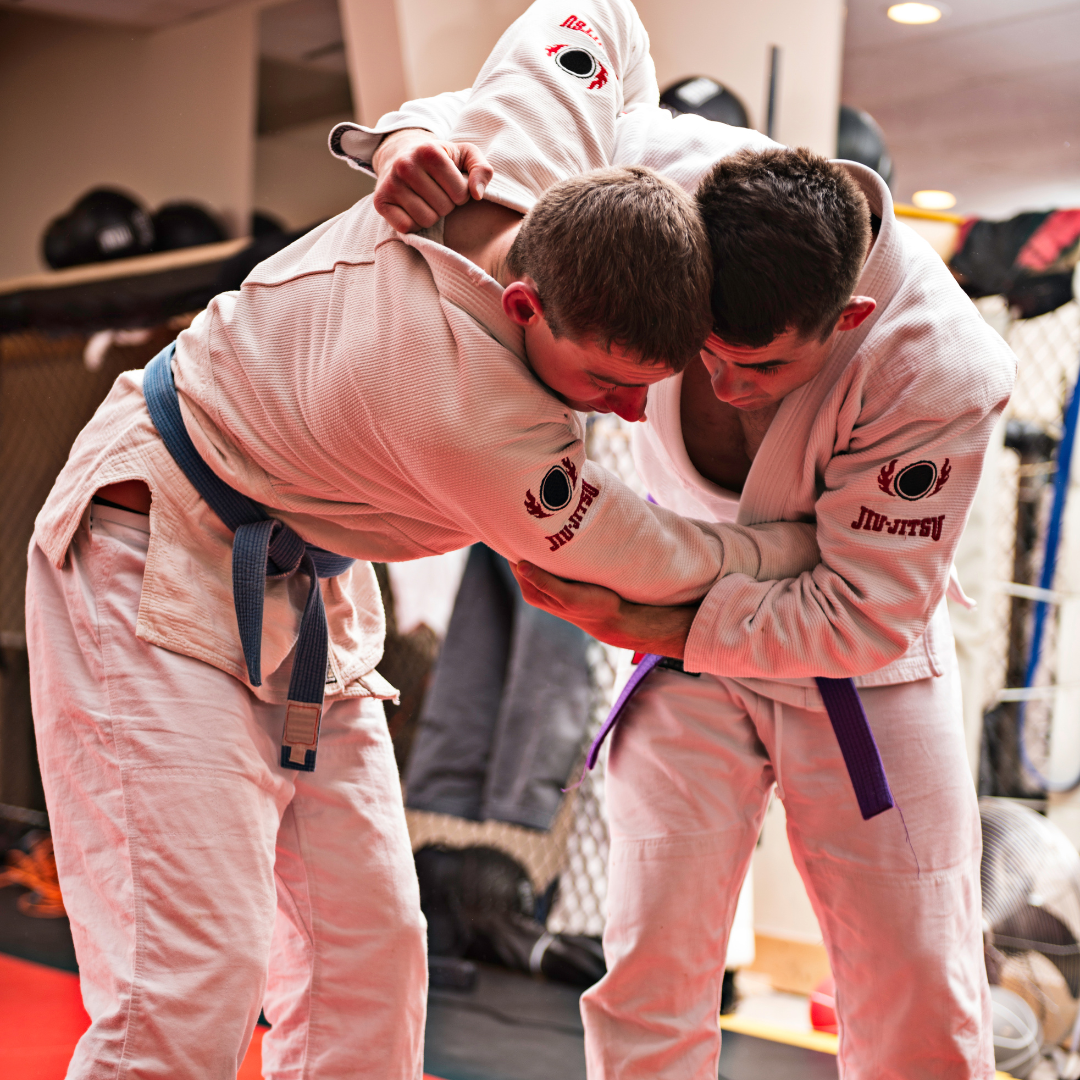
Weighing in for Gi Tournaments
A Gi competition should be pretty strict when it comes to weigh-ins. Cutting weight is not recommended due to hydration issues and one is recommended to compete at their natural body weight. Reading the contest’s rulebook should prove helpful in meeting the requirements.
Frequently Asked Questions
How Do Weigh-Ins Work for IBJJF Gi Tournaments?
The athlete is supposed to weigh in while wearing their Gi on the very same day of the competition. If they aren’t able to make weight, they’ll be disqualified without a refund.
How can I see the weight classes for my specific competition?
You can simply visit the website of the organization and find the weight divisions there. If it is a big organization, you can easily find weight classes on a blog like this one.
Will I get a refund if I don’t make weight?
The norm is that you won’t get a refund if you miss weight. Likely, they won’t allow you to compete at a higher-weight class either. But then again, checking your competition’s rulebook should give you the exact answer.
How much does a Gi weigh?
A Gi can weigh as much as 0.9 kg or 5 lbs and as low as 2.26 kg or 2 lbs. This is why Gi competitions have slightly higher weight limits as compared to No Gi contests – to compensate for the added weight.

